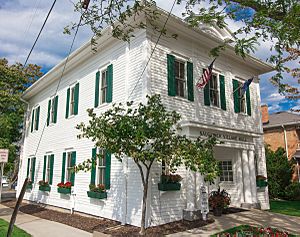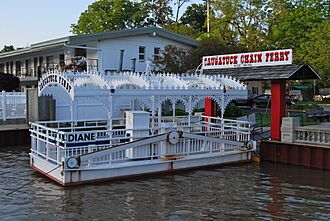Saugatuck, Michigan facts for kids
Quick facts for kids
Saugatuck, Michigan
|
||
|---|---|---|

Saugatuck Engine House
|
||
|
||

Location of Saugatuck, Michigan
|
||
| Country | United States | |
| State | Michigan | |
| County | Allegan | |
| Incorporated | 1868 | |
| Area | ||
| • Total | 1.77 sq mi (4.58 km2) | |
| • Land | 1.39 sq mi (3.60 km2) | |
| • Water | 0.38 sq mi (0.98 km2) | |
| Elevation | 594 ft (181 m) | |
| Population
(2020)
|
||
| • Total | 865 | |
| • Density | 621.85/sq mi (240.02/km2) | |
| Time zone | UTC-5 (Eastern (EST)) | |
| • Summer (DST) | UTC-4 (EDT) | |
| ZIP code |
49453
|
|
| Area code(s) | 269 | |
| FIPS code | 26-71700 | |
| GNIS feature ID | 0637271 | |

Saugatuck is a city located in Allegan County, in the U.S. state of Michigan. In 2020, about 865 people lived there. The city is part of Saugatuck Township, but it manages its own government.
Saugatuck started as a town focused on lumber and shipping. Later, it became famous as an art colony and a popular place for tourists. This happened during the Arts and Crafts movement in the late 1800s. In the early 1900s, Saugatuck had a very popular dance hall called the Big Pavilion. Many bands and visitors from all over the Midwest came to this building. It was a favorite spot on Lake Michigan from 1909 until it burned down in 1960.
Today, many visitors come to Saugatuck for its art galleries, beautiful harbor, and unique stores. People also enjoy the view from Mount Baldhead and the famous Oval Beach on Lake Michigan. Nearby, you can find Saugatuck Dunes State Park and Allegan State Game Area. The city is also known as a welcoming vacation spot for many different people.
Contents
History of Saugatuck
Early Settlement and Naming
The first European-American settler in the Saugatuck area was William C. Butler in 1830. He bought land and planned out a village in 1833. At first, the area was called "Kalamazoo village."
In 1836, the state government gave the nearby town of Kalamazoo its current name. So, the local community was renamed Newark. Later, the first postmaster suggested the name Saugatuck for the post office. This name comes from a Native American word that means "stream outlet."
Becoming an Incorporated Village and City
Saugatuck officially became a village in 1868. This was decided by the County Board of Supervisors. The state government then reconfirmed its status as a village in 1869-1870.
The rules for the village were updated in 1893. By 1895, Saugatuck followed the general laws for villages in Michigan. In 1968, Saugatuck had been a village for 100 years. It officially became a city in 1984.
Geography of Saugatuck
Saugatuck covers a total area of about 1.47 square miles (3.81 square kilometers). Most of this area, about 1.18 square miles (3.06 square kilometers), is land. The rest, about 0.29 square miles (0.75 square kilometers), is water.
Tourism in Saugatuck
Tourism is the main way Saugatuck makes money. Only about 1,000 people live in Saugatuck all year. But in the summer, the population grows to almost 3,000. Saugatuck is a popular weekend trip for people from Chicago, Grand Rapids, and Detroit. Many visitors enjoy staying at the many bed and breakfasts in the area. In 2010, Budget Travel magazine named Saugatuck one of the "ten coolest towns in America."
Attractions and Activities
In Saugatuck, you can find many interesting places. There are over a dozen art galleries, small independent shops, and several restaurants. The Star of Saugatuck is a large paddle-wheel boat. It offers daily tours along the Kalamazoo River and Lake Michigan.
The Saugatuck Chain Ferry is a unique, hand-cranked boat. It takes visitors from Wick's Park across the river. From there, people can walk to the beach, visit the historical museum, or climb the stairs at Mt. Baldhead.
Saugatuck also hosts art and music festivals throughout the year. The Saugatuck Center for the Arts offers plays, music concerts, art shows, and educational events. It also has a green market.
Nearby Places of Interest
The nearby town of Douglas is Saugatuck's sister city. Saugatuck has historic churches that are important to the community. They also help preserve some of the oldest buildings in town. The oldest church is First Congregational Church, started in 1860.
Douglas used to be home to the SS Keewatin. This was a very old coal-fired steamship. It was a floating museum in the harbor for a long time. Recently, it was bought and moved back to Canada.
Population of Saugatuck
| Historical population | |||
|---|---|---|---|
| Census | Pop. | %± | |
| 1870 | 1,026 | — | |
| 1880 | 794 | −22.6% | |
| 1890 | 799 | 0.6% | |
| 1900 | 707 | −11.5% | |
| 1910 | 621 | −12.2% | |
| 1920 | 526 | −15.3% | |
| 1930 | 696 | 32.3% | |
| 1940 | 628 | −9.8% | |
| 1950 | 770 | 22.6% | |
| 1960 | 927 | 20.4% | |
| 1970 | 1,022 | 10.2% | |
| 1980 | 1,079 | 5.6% | |
| 1990 | 954 | −11.6% | |
| 2000 | 1,065 | 11.6% | |
| 2010 | 925 | −13.1% | |
| 2020 | 865 | −6.5% | |
| U.S. Decennial Census | |||
Population Details from 2010
In 2010, there were 925 people living in Saugatuck. These people lived in 513 households, and 243 of these were families. The city had about 784 people per square mile (303 people per square kilometer). There were 942 homes, with about 798 homes per square mile (308 homes per square kilometer).
Most of the people in Saugatuck were White (95.6%). A small number were African American (0.6%), Native American (0.6%), or Asian (0.4%). About 0.9% were from other races, and 1.8% were from two or more races. People of Hispanic or Latino background made up 3.8% of the population.
About 14.4% of households had children under 18. About 37.0% were married couples living together. The average household had 1.80 people, and the average family had 2.43 people.
The average age in the city was 53.3 years old. About 12.5% of residents were under 18. About 21.6% were 65 years old or older. The population was almost evenly split between males (50.5%) and females (49.5%).
Images for kids
See also
 In Spanish: Saugatuck (Míchigan) para niños
In Spanish: Saugatuck (Míchigan) para niños








